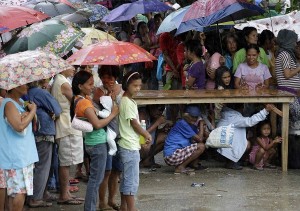Bohol quake victims find time to visit dead
LOON, Bohol—Elenita Bacalso and her 14-year-old daughter lighted two candles at the graves of her grandparents in the public cemetery here. They didn’t stay long.
Bacalso said she cleaned the graves and promised her grandparents that she would have the tombs improved.
When, she could not say.
But definitely it would be after she had rebuilt her family’s house that collapsed during the Oct. 15 earthquake that killed more than 200 people in Central Visayas.
After praying, mother and daughter left.
Article continues after this advertisementBacalso said she had to find food for her children, as it had been three days since she last received relief from the Department of Social Welfare and Development (DSWD) and the municipal government.
Article continues after this advertisementLike other cemeteries in Bohol province, epicenter of the 7.2-magnitude earthquake, the Loon cemetery was quiet a day before All Saints’ Day.
Caretaker Terencio Calabria said the cemetery used to be filled with people on this day every year, but this year people were taking care of the living rather than the dead.
More than 380,000 people in Bohol lost their homes during the earthquake, and they are now living in tents and being fed by the national and the local governments.
Officials keep saying the government has enough relief stocks to feed all the displaced, but apparently not every day or Bacalso and her children would not go without food for three days.
Home watch
Calabria said people who were not in the evacuation centers pitched tents in front of their damaged homes and stayed there to watch their belongings.
His wife, Buena, said that usually they would receive requests for repainting and cleaning tombs as early as Oct. 30.
But they said they had not received even a single request when the Inquirer visited the Loon cemetery on Thursday.
The couple sat on a tomb under a mango tree, waiting for customers.
“It’s supposed to be festive on this day, but it’s very quiet,” Buena said.
The Inquirer looked around and counted only 10 visitors.
And like Bacalso and her daughter, they did not stay long. They lighted candles at the graves of their departed relatives, prayed and left, either for the tents in the evacuation centers or to their damaged homes to keep looters away.
There were no tents, unlike in previous years when people would camp out in the cemetery starting Oct. 30 to avoid the Nov. 1 crush.
And there was not a single flower or candle vendor around.
Tombs destroyed
The air was foul, as the earthquake destroyed about 200 tombs, exposing the coffins and the bones and the decomposing bodies of eight people who were buried just days before the temblor struck.
Calabria said caretakers could not touch the bodies without the relatives’ permission.
But no relatives have shown up to give instructions, Calabria said.
It was also quiet in the public cemetery in the adjacent town of Maribojoc where the earthquake destroyed 70 tombs, according to caretaker Raul Vendencia.
Unlike in the Loon cemetery, Vendencia said, the air in the Maribojoc cemetery was not befouled because the coffins in the destroyed tombs remained intact, keeping the corpses and the skeletons tightly shut in.
But like in the Loon cemetery, only a handful of people came to the Maribojoc cemetery to light candles and pray for their departed relatives.
And like Bacalso and her daughter in Loon, they also did not stay long.
Bernardina Magdoza, a resident of Bood village in Maribojoc, planned to go to the cemetery on All Saints’ Day and light candles for her 91-year-old aunt, Luisa, who was killed during the earthquake.
But she said she would not stay long because she had three children to take care of.
Good aunt
“I’m sad that she died. She was a good person and we were close. But I don’t have a choice. My children have cough. I have to attend to them first,” Magdoza said.
Luisa was sitting on a bamboo bench in Magdoza’s house waiting for Magdoza to get her a pack of detergent that Tuesday morning when the earthquake struck.
Magdoza dove and covered her year-old daughter with her body. But she saw Luisa lying on the floor, knocked down by falling debris.
Once the earth stopped heaving, Magdoza said she called for help and neighbors laid Luisa on a wooden door that the quake had torn off the wall of the house.
“She kept on asking what happened to her house, what happened to her neighbors. She said it was the strongest quake she had experienced,” Magdoza said.
Luisa’s house was about 20 meters away from Magdoza’s.
Magdoza said people put Luisa on a multicab and took her to Congressman Natalio Castillo Memorial Hospital in Loon, the nearest hospital in the area, but she died along the way.
The hospital itself also collapsed during the earthquake and the staff had to set up makeshift tents for the patients.
Delayed burial
It took a week before Luisa could be buried, as the funeral homes were suddenly full after the deadly earthquake and staffs could not cope.
Now Magdoza was talking about paying her aunt a brief visit on All Saints’ Day.
Luisa would understand. Her niece had other things to take care of besides looking after her children, like finding a way to rebuild her house that was destroyed by the earthquake.
RELATED STORIES:
Mormons helping Catholic Church distribute relief goods in Bohol
Relief goods reaching Bohol hardly enough for suffering families
